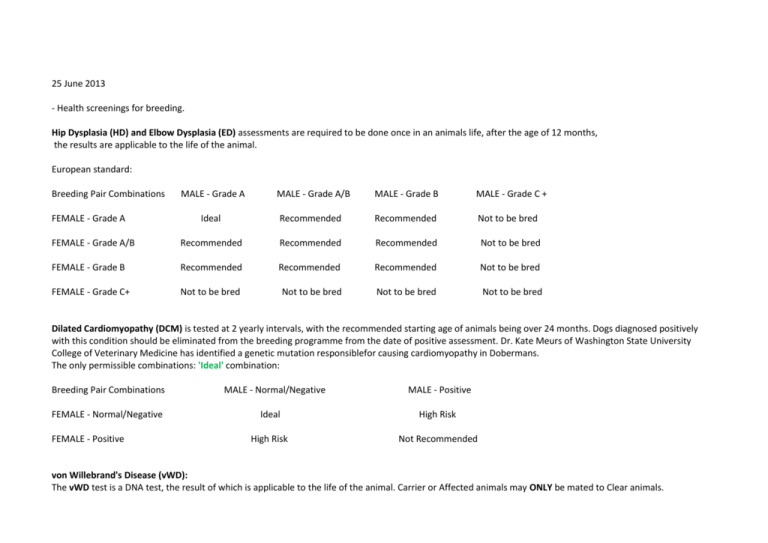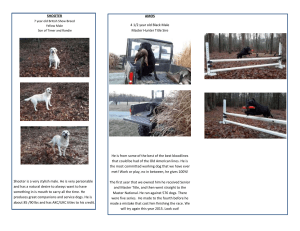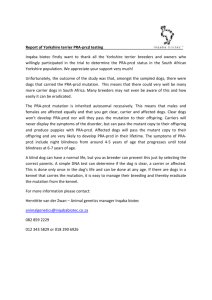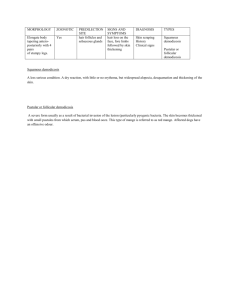Health screenings for breeding. WORD
advertisement

25 June 2013 - Health screenings for breeding. Hip Dysplasia (HD) and Elbow Dysplasia (ED) assessments are required to be done once in an animals life, after the age of 12 months, the results are applicable to the life of the animal. European standard: Breeding Pair Combinations MALE - Grade A MALE - Grade A/B MALE - Grade B MALE - Grade C + Ideal Recommended Recommended Not to be bred FEMALE - Grade A/B Recommended Recommended Recommended Not to be bred FEMALE - Grade B Recommended Recommended Recommended Not to be bred FEMALE - Grade C+ Not to be bred Not to be bred Not to be bred Not to be bred FEMALE - Grade A Dilated Cardiomyopathy (DCM) is tested at 2 yearly intervals, with the recommended starting age of animals being over 24 months. Dogs diagnosed positively with this condition should be eliminated from the breeding programme from the date of positive assessment. Dr. Kate Meurs of Washington State University College of Veterinary Medicine has identified a genetic mutation responsiblefor causing cardiomyopathy in Dobermans. The only permissible combinations: 'Ideal' combination: Breeding Pair Combinations FEMALE - Normal/Negative FEMALE - Positive MALE - Normal/Negative MALE - Positive Ideal High Risk High Risk Not Recommended von Willebrand's Disease (vWD): The vWD test is a DNA test, the result of which is applicable to the life of the animal. Carrier or Affected animals may ONLY be mated to Clear animals. Breeding Pair Combinations MALE - Clear FEMALE - Clear 100% Clear 50/50 Carrier/Clear 100% Carrier 50/50 Carrier/Clear 25/50/25 Clr./Carr./Affctd. 50/50 Carrier/Affected 50/50 Carrier/Affected 100% Affected FEMALE - Carrier FEMALE - Affected MALE - Carrier 100% Carrier MALE - Affected Ideal Breeding Pair. Puppies will not have the disease gene (neither as Carrier nor as Affected). Breeding Is Safe. No Affected puppies will be produced. However, some or all puppies will be Carriers. Accordingly, it is recommended that Carrier dogs which are desirable for breeding be bred with Clear dogs in the future, which will produce 50% carrier and 50% clear animals, to further reduce the disease gene frequency. These offspring should be tested for the defective gene, and if possible, only the clear animals in this generation should be used. High Risk Breeding. Some puppies are likely to be Carriers and some puppies are likely to be Affected. Even though it is possible that there will be some clear puppies when breeding 'Carrier to Carrier', in general, neither this type of breeding pair nor 'Carrier to Affected' are recommended for breeding. Breeding Not Recommended. All puppies will be genetically Affected. Eye Tests: There are various eye problems and diseases that are currently tested for. PHTVL/PHPV only needs to be tested for once during the dogs lifetime as it is genetically inherited, the result at the time of testing is applicable for the life of the dog. This test is done on breeding stock and the veterinary specialists in this field have been asked to consider introducing the grading system. Should this grading system be possible the guidelines would be 'Ideal' or 'Recommended' combinations only: Breeding Pair Combinations FEMALE - Clear MALE - Clear MALE - Unilateral* Grade 1 MALE - Grade 1 MALE - Grade 2 MALE - Grade 3+ Recommended High Risk Not to be bred Ideal Recommended FEMALE - Unilateral* Grade 1 Recommended Recommended High Risk High Risk Not to be bred FEMALE - Grade 1 Recommended High Risk High Risk High Risk Not to be bred High Risk High Risk High Risk Not to be bred Not to be bred Not to be bred Not to be bred FEMALE - Grade 2 FEMALE - Grade 3+ High Risk Not to be bred Not to be bred * = spots in one eye only Other eye diseases and problems should be tested for on an annual basis as these can develop later in the dogs life and some of them are degenerative. Thyroid: TSH and T4 tests can be done but results are only valid at the time of testing. Testing is available from your usual vet if you feel your dog has symptoms indicating a problem. These are only screening tests and the three possible grading areas are 'Normal', 'Grey-area' and 'Hypothyroidism'. Inheritability of thyroid dysfunction in dogs is low. Canine Herpes Virus (CHV-1): The Canine Herpes Virus (CHV-1) is highly infectious and seems to have been underplayed by Veterinarians and Breeders alike for many years. CHV-1 belongs to the family Herpesviridae and is a typical alpha-herpes virus. Although it infects dogs of all ages, it is only a serious problem when it attacks newborn puppies. The virus grows only in canine cells and growth is best in kidney or testicular cells, optimally at 34 - 35°C. These viruses produce intranuclear inclusions in infected cells. Cervical Vertebral Instability (CVI, Wobblers): This disease is caused by compression of the cervical spinal cord as a result of cervical vertebral malformationmalarticulation or instability. Spinal cord compression injures the portion of the spinal cord necessary for an animal to stand and move normally. In Dobermanns, the skeletal abnormality occurs predominantly in the last three cervical vertebrae (the fifth, sixth and seventh cervical vertebrae). The cause of the skeletal malformation or malarticulation is unknown. Clinical studies suggest both genetics and nutrition may play a role in the development of the defects. Research has shown that, in some young dogs, excessive intake of a diet high in protein, energy, calcium, and phosphorus accelerates growth, which may induce skeletal changes such as those seen in some "wobbler" dogs. Demodectic Mange, also called "demodicosis," is caused by a microscopic mite of the Demodex genus. All dogs raised normally by their mothers possess this mite as mites are transferred from mother to pup via cuddling during the first few days of life. Most dogs live in harmony with their mites, never suffering any consequence. If, however, conditions change to upset the natural equilibrium (such as some kind of suppression of the dog's immune system), the Demodex mites may "gain the upper hand." The mites proliferate and can cause serious skin disease. Demodectic mange (unlike Sarcoptic mange http://www.marvistavet.com/html/body_sarcoptic_mange.html) is not considered contagious and mites cannot be transmitted to humans or to cats. The tendency to be susceptible to demodectic mange is hereditary. Dogs with demodectic mange usually have an immune system deficiency; it is this deficiency that appears to be inherited, making the pup unable to keep the demodex mites under control. The current recommendation is not to treat puppies with demodex, so that it can be determined if the condition will stay localised and resolve or if it will generalise. If it stays localised and eventually resolves without treatment, the animal is still a candidate for breeding. If the condition generalises to cover the entire body, the animal should be sterilised. If the condition receives treatment and resolves, we will never know how far the disease would have gone in its natural state and will not know whether the pup is carrying the genetic predisposition for demodectic mange. Localised demodicosis is almost exclusively a "puppyhood" disease. When a puppy develops localised demodicosis the chance of the condition resolving is 90% unless there is a family history of demodicosis in related dogs. In this case, chance of spontaneous resolution drops to 50%. Occasionally an adult dog develops localized demodicosis. We currently do not have good understanding of the prognosis or significance of this condition in an adult dog.









